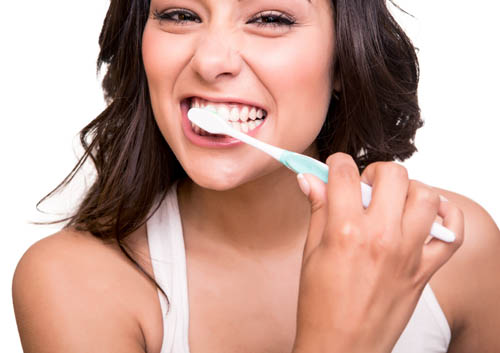May 5th, 2017

Most people think braces are all about their teeth. While it is true orthodontics is meant to move your teeth into proper position, there's more to it than that. To safely move your teeth with braces, you're going to need healthy and stable gums (or periodontium—the tissues that support your teeth).
For this reason it's critical to have your periodontal health evaluated prior to getting braces. This applies particularly to adults, since a 2013 study by the Center For Disease Control found that an estimated 47.2% of adults 30 years of age and older had periodontitis (gum disease). If you do have periodontitis, moving your teeth with braces will only make things worse.
Conversely, there is also risk for periodontal disease if you don't get orthodontic treatment. Malocclusion, as well as crooked and spaced teeth, can all contribute to periodontal disease. In these situations your teeth and gums are more difficult to clean and become breeding grounds for disease causing bacteria. Bad oral hygiene combined with these traits can greatly contribute to the development of periodontitis.
So, periodontics and braces have a tricky relationship. On one hand, you shouldn't get braces if you show signs of developing or have periodontitis, while on the other hand, braces can help prevent the possibility of developing periodontitis by correcting the bite and straightening the teeth.
If you are 30 years of age or older and are considering getting braces, it would be wise to first:
- Let Dr. Paul Rosel know about your desire to get braces
- Get an exam to make sure you're in good periodontal health and a good candidate for braces
- If you are a good candidate, keep an eye on your teeth and gums and get regular dental checkups throughout your entire course of treatment.
If you are in any doubt about the status of your teeth and gums, it's always best to get them checked before embarking with braces treatment. For more information or to have your periodontal health assessed for braces treatment, please contact our Olathe, KS office.
April 28th, 2017

Brushing your teeth properly removes the food particles and bacteria that can lead to tooth decay and gum disease. However, you do not want to scrub your teeth or gums heavily. A heavy hand can lead to tooth and gum erosion, as Dr. Paul Rosel and our staff see all too often.
You should also use a soft bristle toothbrush to avoid damaging the surface of your teeth. Make sure the head of the brush fits in your mouth, because if it is too large you will not be able to reach all tooth surfaces. Follow these steps to ensure you are brushing properly.
- Use a small amount of toothpaste on your brush. The recommendation is a pea-sized amount or thin strip on the bristles.
- Hold your toothbrush at a 45-degree angle to the surface of your teeth, angling towards your gums. Use a circular motion on all exterior tooth surfaces, and avoid back-and-forth “scrub” brushing.
- Once you have cleaned the outer surfaces, hold the brush vertically and clean the inner teeth surfaces — the side of your teeth that face your tongue. Do not forget the inner surfaces of your front teeth.
- Finally, finish by cleaning all the chewing surfaces of your teeth. You need to maintain a gentle touch, but make sure you get into the full depth of your molars. The entire process should take about two minutes.
Dr. Paul Rosel and our staff recommend changing your toothbrush every three to four months for best results. Do not forget to clean your tongue, which helps remove excess bacteria from your mouth. Special brushes are available just for cleaning your tongue, and they are easy to use.
Proper care of your teeth also requires flossing on a regular basis. Flossing can be performed before or after you brush. Following up with a quality mouthwash will provide you with even more protection. Do not be afraid to ask the Paul D. Rosel, D.D.S. LLC Family and Cosmetic Dentistry team for tips on proper brushing and flossing.
April 21st, 2017

If you're considering getting an implant, you'll most certainly have questions for Dr. Paul Rosel. You might be wondering how a dental implant compares to a real tooth. Let's look at some of the differences between implants and natural teeth.
It should be noted that one of the primary goals of implant dentistry is to try to provide the same form and function as your natural teeth. However, with that in mind, know that an implant is not a tooth. An implant does not decay and does not have dental pulp or periodontal membrane like teeth.
An implant won't always work in every case, but they do have some great advantages when they are called for. Some advantages of an implant:
- Often last for decades without needing to be replaced
- Create a functional and aesthetically pleasing replacement for your missing tooth
- Don't require surrounding teeth for support
- Do not decay like natural teeth
- Can be fixed or removable
- Are able to replace single tooth or multiple teeth
There are downsides to implants where natural teeth win out. The disadvantages of implants include:
- Higher cost compared to traditional dentistry
- It's a surgical procedure which requires a period of healing afterward
- Fracturing of fixtures and loosening of screws can occur (only in about 5% of patients)
- Since there is no cushion between the implant and the bone, fracturing of crowns and bridges is more common with implants than with natural teeth, though this is rare.
It's best to speak with Dr. Paul Rosel about your options regarding implants. Let us know what you want to achieve and we'll work with you as best we can to accomplish that. And don't hesitate to contact our Olathe, KS office for further questions about the procedure.
April 14th, 2017

You already know that taking care of your teeth can help prevent tooth decay and the need for extensive work such as root canals or implants, which can be inconvenient and expensive. But the benefits of good teeth can go far beyond having an attractive smile and being able to crunch carrots and chew meat.
The American Dental Association explains that healthy teeth are linked to a lower risk for heart disease and diabetes. Furthermore, recent research published in the British Journal of Sports Medicine states that good teeth can improve athletic performance among elite athletes.
Researchers examined the oral health of nearly 300 athletes in 25 sports at the 2012 Olympics in London. They looked for conditions such as dental caries, gingivitis, dental erosion, and periodontal disease, and asked about recent visits to a dentist.
Study investigators also asked athletes whether their oral health interfered with quality of life or athletic training and performance. The study concluded that poor oral health and fewer dental visits led to interference with preparation for competition.
This can happen for a few reasons. Tooth pain can disrupt sleep, which leads to slower reaction times. Oral health conditions can indicate chronic inflammation in the body, which means suboptimal performances on an elite level. Tooth pain can interfere with focus during training and competition.
Unfortunately, merely taking good care of your teeth won’t turn you into an Olympic gold medalist. However, the benefits can still be worthwhile. Even if healthy teeth provide little if any detectable gain in your athletic abilities, the potential benefits of maintaining a healthy mouth clearly go far beyond an attractive smile.
Practicing good oral hygiene and seeing Dr. Paul Rosel regularly can promote your physical health, and maybe – just maybe – you will start to achieve an advantage over your weekend athletic opponents.




